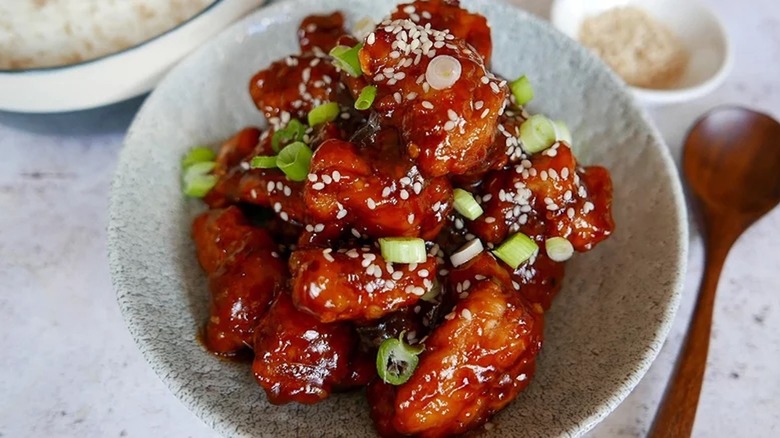J. Kenji López-Alt's Unexpected Addition For Crispier General Tso's Chicken
Even if you aren't a gambler, you might be willing to bet that most people who have eaten Chinese food have tried General Tso's chicken. According to NPR, the sweet and spicy battered chicken has established global notoriety as a favored meal option at Chinese food restaurants and home kitchens worldwide except, ironically, in China. Delighting palates with its tangy sauce and craveable crunch, Homemade General Tso's Chicken couldn't get any better, or could it?
Although the popular chicken dish was named after revered Hunanese General Tso Tsung-t'ang, there is no mention of the recipe in Hunan's food and cooking records. What is documented is the migration of defeated Nationalist party members who relocated to Taiwan after the Chinese civil war. Among those fleeing China was a talented chef named Peng Chang-kuei, who honed his craft in Taiwan before moving to New York in 1973 to introduce westerners to traditional Hunanese cuisine. His food caught the attention of Henry Kissinger, and as his restaurant gained popularity, Chang-kuei began creating new dishes and tweaking traditional Chinese fare to suit American palates.
Bold, tangy, and spicy flavors are typical tastes in Hunanese food, and when Chef Chang-kuei added sugar to a traditional chicken recipe, he created a complex and undeniably delicious dish that became a global phenomenon. Chefs began imitating his dish and improving (if possible) what we now know and love — General Tso's chicken.
Cheers to the addition of vodka
J. Kenji López-Alt is a busy person, what with his best-selling cookbooks like "The Food Lab" and day jobs as a New York Times food writer and Chief Culinary Advisor for Serious Eats. The talented foodie doesn't shy away from a challenge, so it's no surprise that he took on improving the ever-popular and already tasty General Tso's chicken.
The signature sauce in López-Alt's General Tso's chicken strikes a delectable balance between sweet and tangy with complex flavors and aromas developed by a lower cooking temperature. But it's the addition of vodka to the delicate batter that envelops the chicken and acts as a sauce vehicle that has us standing at attention. Before coating his chicken in a thin cornstarch flurry, López-Alt cuts it with vodka, resulting in a crispier coating.
The gluten in a coating often becomes chewy after being sauced or as it cools, but Vodka is a gluten inhibitor that lessens its development, keeping it crispy after frying. Alcohol also evaporates faster than water, so having a splash of vodka in the batter means that it will fry up quicker and retain less water when it hits the hot oil. López-Alt also adds a drizzle of the vodka-cut batter to the dry dredging mix before tossing his chicken in to create a coating that fries up super crispy and features nooks and crannies that won't go soft when they feature that signature General Tso's sauce.

